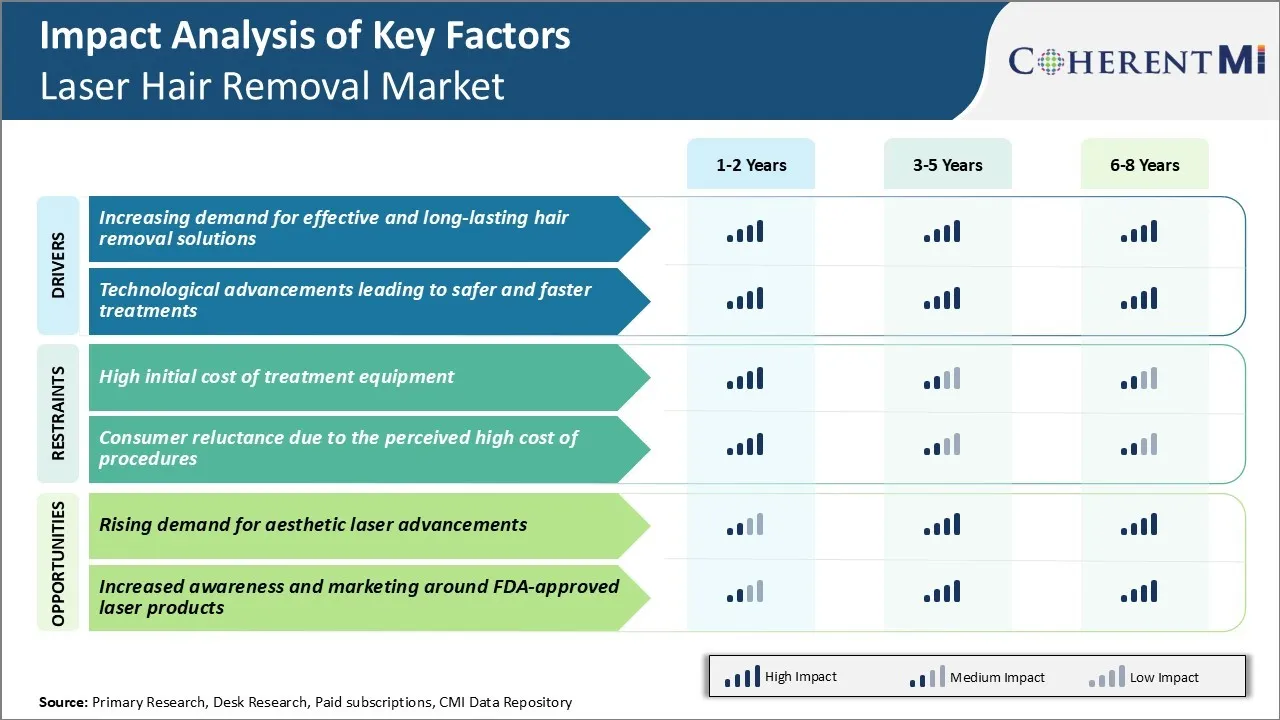Laser Hair Removal Market Trends
Market Driver - Increasing Demand for Effective and Long-Lasting Hair Removal Solutions
The demand for convenient yet long-lasting hair removal solutions has been rising steadily over the past decade. Laser hair removal has emerged as one of the most sought-after options due to its proven efficacy in providing lasting hair reduction.
Laser treatment provides a more permanent solution by damaging the papilla or bulge at the bottom of the hair follicle from where new hair grows. Once the required number of sessions are over, the hair takes a very long time to grow back, if at all in some cases. This has transformed people's lifestyle by saving them on upkeep costs as well as time spent on hair removal.
Another major factor is the desire to slow down or halt the hair growth process as people age. Hormonal changes cause many to experience increased growth of unwanted hair on the body and face. Laser treatment is able to regulate this by damaging the cells responsible for hair fiber production. This has become an important consideration for those who wish to maintain a hair free look with minimum effort, which will remain the top driver for growth of the laser hair removal market.
Market Driver - Technological Advancements leading to Safer and Faster Treatments
The laser hair removal market has seen tremendous technological progress over the past decade. Manufacturers have invested heavily in research and development to design new laser and light-based devices as well as upgrade existing ones. A key goal has been to make the procedures more effective while reducing potential side effects like pain, discomfort and skin damage. The innovations have helped address customer concerns and boosted their confidence in the treatment method.
Treatment times have become significantly faster with the introduction of large spot size handpieces that cover more surface area in one sweep. This improves efficacy as well as customer convenience. Another innovation is fractionated laser technology that delivers microscopic therapeutic treatments in a pinpoint manner with minimal discomfort. Touchscreen interfaces allow customized settings for different body parts and complexions. Remote controlled robotic arms have automated some steps as well.
Such advancements are helping laser hair removal gain popularity by addressing customers' core concerns. With continued improvements focusing on safety, comfort and precision, the market is expected to attract a wider consumer base going forward.

Market Challenge - High Initial Cost of Treatment Equipment
One of the key challenges faced by players in the laser hair removal market is the high initial cost of treatment equipment. The laser machines and devices used for hair removal procedures are quite expensive. For instance, advanced laser systems that use newer technologies like fractionated laser therapy can cost over $100,000.
Establishing a new laser hair removal clinic requires making a sizable capital investment in high-end laser machines. This increases the entry barriers for small businesses and individual practitioners. The need to recover the high equipment costs through multiple treatments also places an upward pressure on service prices.
While this ensures adequate returns on investment, it also risks pricing out certain customer segments. Players in the laser hair removal market need to consider financing and leasing options to make advanced laser technology accessible to smaller clinics and practices. Provider training on machine maintenance and maximizing its life is also important to improve return on initial investment.
Market Opportunity - Rising Demand for Aesthetic Laser Advancements
A major opportunity in the global laser hair removal market is the rising demand for advanced laser-based aesthetic treatments. With an increased awareness about aesthetic procedures, more people are opting for non-invasive hair reduction methods. This has encouraged laser manufacturers to continuously invest in R&D to develop new laser technologies that deliver more effective and comfortable hair removal results.
The introduction of products incorporating features like variable pulse durations, enhanced cooling systems and upgraded medical-grade lasers is expanding the market potential. The growing popularity of laser hair removal among both women and men is also driving a demand for specialized laser devices targeting different hair and skin types.
Players in the laser hair removal market can capitalize on this by launching innovative laser systems tailored for body parts like face, bikini area etc. Manufacturers differentiating through advanced features will be better positioned to increase their market share in the growing aesthetic laser industry.